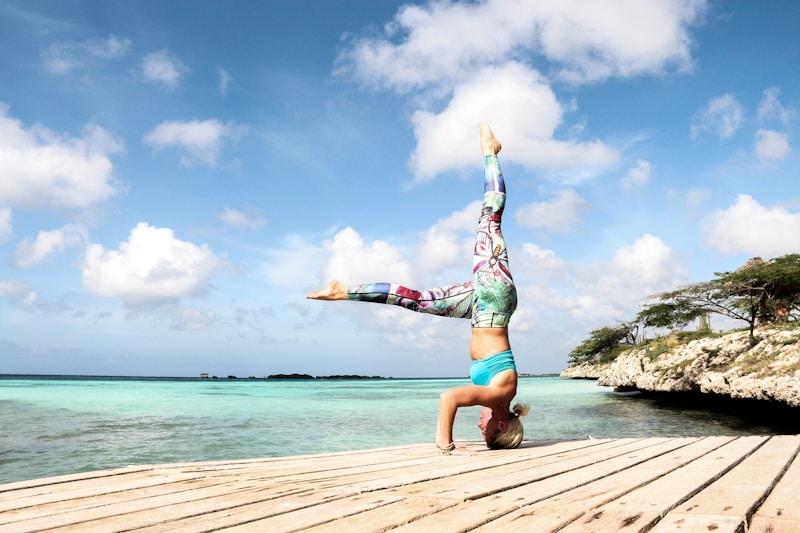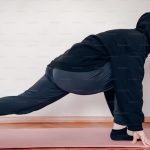Headstand is one of my favourite poses. A headstand demands much. It requires strength AND flexibility, but that is not all. Turning upside-down and balancing on your head takes courage. And self-belief. A headstand is a mental and physical challenge that, once mastered, continues to be a highlight of time spent on the mat.
Though many of us effortlessly stood on our heads as children, it seems that it is a skill lost to us as adults. So often life robs us of the physical attributes and self-belief that a headstand demands. For me, a headstand requires four things – four things that can be relearnt and woven together to become the joy that your first adult headstand will be. And it is truly a joy.
So What is a Headstand?
A yoga headstand is usually salamba sirsāsana or sirsāsana 1- ‘the king of all poses’ and one of the twelve original poses of hatha yoga. Here the weight of the body is supported on the forearms and head, with the legs in line with the body. Having said that, there are a whole host of variations to headstand – sirsāsana 2 (tripod headstand); mukta hasta sirsāsana (no hands) and any number of leg positions from padmāsana (lotus) to garudāsana (eagle) legs. The world is your oyster.
Preparation Pathway
The journey to a headstand is a long one path paved with many smaller goals. It is a wonderful journey – full of achievement and self-awareness. For me, it took two years. Twenty-four months of patient, mindful practice, then one day it just came together and there I was upside-down. Have I persuaded you to step on to this path? I hope so. And this is how you can get there.
1. LONG HAMSTRINGS
To be able to get into a headstand you need a whole lot of length down the back of the body. Particularly in the hamstrings. Short hamstrings draw the pelvis forwards from their ideal position directly over the shoulders and head before you lift the legs. This forward pelvic position makes balancing incredibly hard when you lift the second leg.
The solution? Working on hamstring length within a practice before attempting the pose can work if your hamstrings are nearly long enough.
But for most of us, it will be a case of working on hamstring length over weeks or maybe months before you can achieve that ideal of hips over head. My favourite poses for this are parsvottanāsana (intense side stretch), janu sirsāsana (head to knee pose) and every version of uttanāsana (forward fold).
2. SUPER SHOULDERS
While balancing in headstand, the forearms are actively pushing down into the mat to allow the body to grow upwards from a firm base. All of the muscles around the shoulder blade are engaged to stabilise the actual shoulder joint. It takes time and effort to build enough strength in the right places to achieve this action. This is where arm balancing poses will help – adho mukha śvānāsana (down dog) and any plank variations are a great place to start. As your shoulders strengthen up move on to ardha pincha mayurāsana (dolphin) and maybe bakāsana (crow) as they will really reap further benefits for your upper body strength.
3. CORE CONTROL
Headstands need core strength in spades. Your core is what provides the stable foundations from which you can lift your legs. It is what gives the inversion stability and balance. Core strength can even compensate for lack of hamstring length or upper body strength.
My favourite core strengtheners are side planks and planks in any variations you like. They are great for static strength. But what about the dynamic strength needed in the core as the legs leave the ground and float overhead? For that, you need a dynamic workout. I use forearm plank into dolphin and back. Repeated 5, 10, 20, 30 times – starting with just a few reps and gradually building up by adding one or two reps each week. As a strength and conditioning workout this exercise is best done on alternate days – not every day. It is fabulous at getting a strong and toned core – what’s not to love?
4. COURAGE
For me, this is the keystone of any inversion. You can have all of the physical elements of a headstand in the bag, but if your head won’t let you turn upside-down it will never work. It takes nerve to balance on your head. It is natural to fear toppling over and hurting yourself. So how can we work to build the courage up to try our first headstand?
Spend time in dolphin – stay there for a few breaths at a time. Try lifting one leg at a time to get the body used to the action needed to get into headstand in the future. Try using the headstand arm and head position in a variation of dolphin and walk the feet towards the head to work on getting the hips over the shoulders. This also helps you to get used to being upside-down. One day you will feel a delicious lightness in the body as you reach the point of balance. Here is where leg lifting is possible. If you find this point – practice lifting one leg at a time in line with the body into one-legged headstand. And when you can do this you are almost ready for the full expression of the pose.
But most importantly – imagine yourself floating into the perfect headstand. Picture yourself poised on your head as you breathe deeply. Explore how it will feel and what you will see in your mind’s eye. Did you know that imagining an activity actually lights up the same parts of the brain that we need to physically do an activity? This sets up the neural pathways needed to succeed. It makes that activity familiar and altogether less scary when you try it for real. Isn’t that amazing?
Bringing it All Together
The path to a perfect headstand is not always smooth. You may find some of the elements come easily but others elude you for months. Be patient. Do not rush. Headstands are worth waiting for.
And of course, not every yogi will be able to achieve a full headstand. Injuries may make it impossible. Headstands are traditionally contraindicated for folk with high blood pressure or hiatus hernia amongst other things. I would also add that anyone with neck problems should think carefully before attempting the full expression of the pose. This is where a headstool still might be worth considering if you want to invert but not put pressure on your neck.
I really hope you enjoy your journey to headstand as much as I have enjoyed mine. It has been one of the most satisfying yoga poses I have, as yet, accomplished. I wish you happy headstand-ing!













